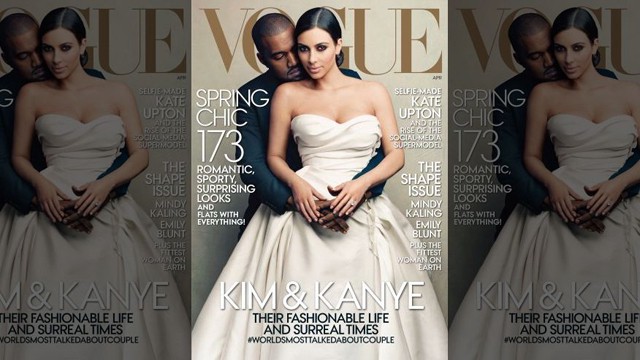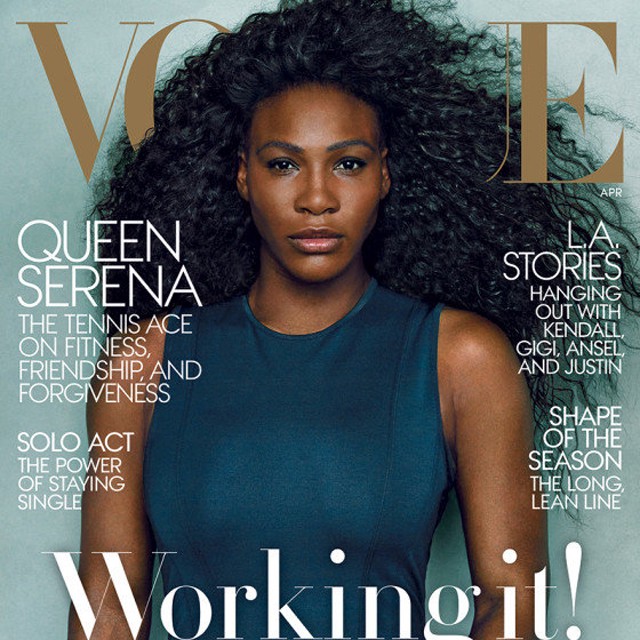#WorldsMostTalkedAboutMagazine

Yesterday Durga emailed Jazmine and I to remind us that it was the one-year anniversary of this piece I wrote; if she hadn’t, I definitely would have not remembered, and even if I had, my own conservative estimate would have been that I wrote that approximately ten years ago, because it just feels like so much time has elapsed. I kind-of-but-also-so-seriously joked about doing a “Where Are They Now” follow-up to the piece, like, “Anna Wintour: still a troll. Kanye West: dancing like a dad. Kim Kardashian: perfection achieved” but THEN

Ok. Let’s talk about my feelings, because they are, as you’ve probably guessed, plentiful.
Talking about Vogue and what I think is wrong with Vogue and right with Vogue has kind of become my thing, enough so that I have friends emailing me about the anniversary of when I finally sat down and unleashed a real hurricane of feels in the direction of that Kimye cover, not to mention the texts I get or unrelated emails that just keep me informed of general Vogue happenings. And that’s because I genuinely think that Vogue is, as far as mainstream fashion magazine goes, an excellent magazine, and I also think that it is an excellent target for looking at exactly what is wrong with both mainstream fashion magazines and the fashion industry. When we — lol jk I — criticize Vogue, we’re identifying a fair target; we’re punching up. We’re asking a cultural institution that we — lol I — have a lot of respect for, and so, we — LOL YES I KNOW JUST ME I’M THE ONLY ONE THAT CARES THIS MUCH — to do better. And this cover with Serena Williams is better, and definitely the best of the year so far, and will maybe, considering who follows this cover, be the best of 2015.
I’ve been reading the new Renata Adler collection of essays and she said one thing about cultural criticism that I cannot stop thinking about. Wait here while I go get the book.
Ok, found it. This is from her essay “On Violence: Film Always Argues Yes,” originally titled “The Movies Make Heroes Of Them All” and was published in the New York Times in January 1968.
The motion picture is like journalism in that, more than any of the other arts, it confers celebrity. Not just on people — on acts, and objects, and places, and ways of life. The camera brings a kind of stardom to them all. I therefore doubt that film can ever argue effectively against its own material; that a genuine antiwar film, say, can be made on the basis of even the ugliest battle scenes; or that the brutal hangings in The Dirty Dozen and In Cold Blood will convert one soul from belief in capital punishment. No matter what the filmmakers intend, film always argues yes. People have been modeling their lives after film for years, but the medium is somehow unsuited to moral lessons, cautionary tales or polemics of any kind…Movies glamorize, or they fail to glamorize. They cannot effectively condemn — which means that they must have special terms for dealing with violence.
So I can’t stop thinking about this passage, so much so that I’m forcing it to work on my behalf on a completely unrelated point about the magazine Vogue, which is, of course, not a film studio (yet), but I am just so consumed by her point that film, like journalism, can only glamorize or fail to glamorize, that there is no real condemnation that can be done by either medium, because just by the choice of spotlighting your object or subject, you’ve given it that glow of celebrity. Because sometimes I think we look at a publication like Vogue and still think that the women (and occasional men) are chosen because they are already celebrities, or people worthy of our attention, and though they often are, that does gloss over the effect that Vogue can have on the perception of an already public person and the way they choose to distribute that effect. Vogue glamorizes, and when they choose Taylor Swift and Karlie Kloss as their subjects for said glamour (like seriously lol), they’re glamorizing not just two very young, very famous, very conventionally attractive, very wealthy, very successful white girls, they’re glamorizing those identities as inherently glamorous, which of course they are, but the implication remains that the identities lacking in those traits are excluded because they lack glamour and thus are not worthy of Vogue’s star-making power.
When a public figure like Serena Williams is on the cover of Vogue, my instinct is to go “of course it’s about fucking time,” but I do want to take a second and think about this in a “Where Are They Now” kind of context: one year after #WorldsMostTalkedAboutCover, Vogue has chosen to glamorize the life and work of a woman who is probably one of the world’s greatest living athletes, not that I know anything about sportsball, but I feel pretty comfortable with that sweeping statement, and they’ve produced a beautiful cover that, not to give Vogue too much credit because I’m still side-eying them forever, celebrates Serena Williams specifically and also allows for the possibility of different kinds of beauty, different kinds of celebrity, different kinds of ways to be a woman, different kinds of glamour. I mean, we’ll — lol I’ll — have to wait until we read the article, because you can just never be too careful, but my side-eye has relaxed for a brief moment. Vogue always argues yes; today I am also arguing yes for Vogue.
So, “Where Are They Now: Haley’s Thoughts on Vogue”? Basically the same, but with approximately 15% more respect and a 70% higher chance that I’ll actually purchase this issue. Anyway, good morning!! What bizarre personal anniversary did you celebrate this weekend?